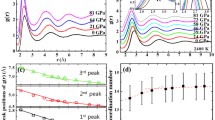Abstract
Results of thermal expansion prediction from atomic scale for metastable liquid metals are reported herein. Three pure liquid metals Ni, Fe, and Cu together with ternary Ni60Fe20Cu20 alloy are used as models. The pair distribution functions were employed to monitor the atomic structure. This indicates that the simulated systems are ordered in atomic short range and disordered in long range. The thermal expansion coefficient was computed as functions of temperature and atom cutoff radius, which tends to maintain a constant when the cutoff radius increases to approximately 15 Å. In such a case, slightly more than 1000 atoms are required for liquid Ni, Cu, Fe and Ni60Fe20Cu20 alloy, that is, the macroscopic thermal expansion can be predicted from the volume change of such a tiny cell. Furthermore, the expansion behaviors of the three types of atoms in liquid Ni60Fe20Cu20 alloy are revealed by the calculated partial expansion coefficient. This provides a fundamental method to predict the macroscopic thermal expansion from the atomic scale for liquid alloys, especially in the undercooled regime.
Similar content being viewed by others
References
Zheng J P, Birktoft J J, Chen Y, et al. From molecular to macroscopic via the rational design of a self-assembled 3D DNA crystal. Nature, 2009, 461: 74–77
Zhu X, Lv B, Wei F, et al. Disorder-induced bulk superconductivity in ZrTe3 single crystals via growth control. Phys Rev B, 2013, 87: 024508
Schuh C A, Lund A C. Atomistic basis for the plastic yield criterion of metallic glass. Nat Mater, 2003, 2: 449–452
Levashov V A, Morris J R, Egami T. Viscosity, shear waves, and atomic-level stress-stress correlations. Phys Rev Lett, 2011, 106: 115703
Erichsen J, Shiferaw T, Zaporojtchenko V, et al. Surface glass transition in bimodal polystyrene mixtures. Eur Phys J E, 2007, 24: 243–246
Wang H P, Wei B B. Understanding atomic-scale phase separation of liquid Fe-Cu alloy. Chin Sci Bull, 2011, 56: 3416–3419
Wang H P, Chang J, Wei B. Measurement and calculation of surface tension for undercooled liquid nickel and its alloy. J Appl Phys, 2009, 106: 033506
Foroughi H, Abbasi A, Das K S, et al. Immiscible displacement of oil by water in a microchannel: Asymmetric flow behavior and nonlinear stability analysis of core-annular flow. Phys Rev E, 2012, 85: 026309
Van V S, Srinivasan S, Saghir M Z. Thermodiffusion in multicomponent hydrocarbon mixtures: Experimental investigations and computational analysis (vol 131, 114505, 2009). J Chem Phys, 2010, 132: 099901
Eslamian M, Saghir M Z. Dynamic thermodiffusion model for binary liquid mixtures. Phys Rev E, 2009, 80: 061201
Chang J, Wang H P, Zhou K, et al. Rapid dendritic growth and solute trapping within undercooled ternary Ni-5%Cu-5%Mo alloy. Appl Phys A, 2012, 109: 139–143
Dragnevski K, Cochrane R F, Mullis A M. Experimental evidence for dendrite tip splitting in deeply undercooled, ultrahigh purity Cu. Phys Rev Lett, 2002, 89: 215502
Mullis A M, Dragnevski K L, Cochrane R F. The transition from the dendritic to the seaweed growth morphology during the solidification of deeply undercooled metallic melts. Mater Sci Eng A, 2004, 375: 157–162
Corradini D, Rovere M, Gallo P. Structural properties of high and low density water in a supercooled aqueous solution of salt. J Phys Chem B, 2011, 115: 1461–1468
Gheribi A E. Molecular dynamics study of stable and undercooled liquid zirconium based on MEAM interatomic potential. Mater Chem Phys, 2009, 116: 489–496
Hedges L O, Jack R L, Garrahan J P, et al. Dynamic order-disorder in atomistic models of structural glass formers. Science, 2009, 323: 1309–1313
Deville S, Maire E, Bernard-Granger G, et al. Metastable and unstable cellular solidification of colloidal suspensions. Nat Mater, 2009, 8: 966–972
Oh S H, Kauffmann Y, Scheu C, et al. Ordered liquid aluminum at the interface with sapphire. Science, 2005, 310: 661–663
Debenedetti P G, Stillinger F H. Supercooled liquids and the glass transition. Nature, 2001, 410: 259–267
Egry I, Holland-Moritz D. Levitation methods for structural and dynamical studies of liquids at high temperatures. Eur Phys J-Spec Top, 2011, 196: 131–150
Yang F, Kordel T, Holland-Moritz D, et al. Structural relaxation as seen by quasielastic neutron scattering on viscous Zr-Ti-Cu-Ni-Be droplets. J Phys-Condens Matter, 2011, 23(25): 254207
Okada J T, Sit P H L, Watanabe Y, et al. Persistence of covalent bonding in liquid silicon probed by inelastic X-ray scattering. Phys Rev Lett, 2012, 108: 067402
Wang H P, Wei B. Ordered structure formation from disordered atoms within undercooled liquid rhodium. Chem Phys Lett, 2012, 521: 55–58
Wang H P, Luo B C, Wei B. Molecular dynamics calculation of thermophysical properties for a highly reactive liquid. Phys Rev E, 2008, 78: 041204
Yang D, Meng G, Zhu C, et al. Synthesis and thermal expansion of copper nanotubes and nanowires with Y- and step-shaped topologies. Small, 2010, 6: 381–385
Wang H P, Yang S J, Wei B. Molecular dynamics prediction of density for metastable liquid noble metals. Chem Phys Lett, 2012, 539: 30–34
Wang H P, Wei B. Positive excess volume of liquid Fe-Cu alloys resulting from liquid structure change. Phys Lett A, 2010, 374: 4787–4792
Baskes M I. Modified embedded-atom potentials for cubic materials and impurities. Phys Rev B, 1992, 46: 2727–2742
Author information
Authors and Affiliations
Corresponding author
Rights and permissions
About this article
Cite this article
Wang, H., Yang, S. & Wei, B. Predicting macroscopic thermal expansion of metastable liquid metals with only one thousand atoms. Sci. China Phys. Mech. Astron. 57, 2235–2241 (2014). https://doi.org/10.1007/s11433-014-5471-8
Received:
Accepted:
Published:
Issue Date:
DOI: https://doi.org/10.1007/s11433-014-5471-8




